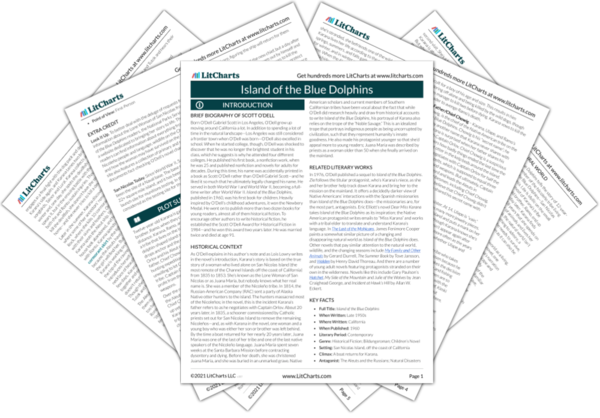Karana’s canoe symbolizes her independence and self-sufficiency. When she first attempts to use a canoe that other members of her tribe made to travel to the mainland, Karana discovers that the canoe is damaged to the point of being dangerous. Not only is it not useful, but this canoe also symbolizes the idea that Karana can no longer rely on her neighbors to protect and guide her. Rather, she must take matters into her own hands and work to ensure her own survival.
Thus, once Karana returns to the Island of the Blue Dolphins, she reworks the canoe not only to make it watertight, but to turn it into a canoe that she can handle by herself as a single woman. The resulting canoe—which Karana acknowledges isn’t as beautiful as it could be, but which is still extremely functional—gives Karana the freedom to explore the sea and the sea caves surrounding the island, as well as the means to travel to the reefs to gather food she’ll need for winter. The canoe gives Karana her freedom and makes her truly self-sufficient; it, more than anything else, enables Karana’s survival during the years she spends alone on the island.
Karana’s Canoe Quotes in Island of the Blue Dolphins
“Most of those who snared fowl and found fish in the deep water and built canoes are gone. The women, who were never asked to do more than stay at home, cook food, and make clothing, must now take the place of the men and face the dangers which abound beyond the village. There will be grumbling in Ghalas-at because of this. There will be shirkers. These will be punished, for without the help of all, all must perish.”

Unlock explanations and citation info for this and every other Island of the Blue Dolphins quote.
Plus so much more...
Get LitCharts A+I was not sure what I would do if the Aleuts came. I could hide in the cave which I had stored with food and water, for it was surrounded by thick brush and the mouth of the ravine could only be reached from the sea. The Aleuts had not used the spring and did not know about it because there was another one closer to where they had camped. But they might come upon the cave by chance and then I must be ready to flee.
For this reason I worked on the canoe I had abandoned on the spit.
The star passed out of sight and another took its place. The tide lifted the canoe higher in the room, and as the water lapped against the walls it sounded like the soft music of a flute. It played many tunes through the long night and I slept little, watching the stars change. I knew that the skeleton who sat on the ledge playing his flute was one of my ancestors, and the others with the glittering eyes, though only images, were too, but still I was sleepless and afraid.
We had many happy times that summer, fishing and going to Tall Rock in our canoe, but more and more now I thought of Tutok and my sister Ulape. Sometimes I would hear their voices in the wind and often, when I was on the sea, in the waves that lapped softly against the canoe.
I came to the mound where my ancestors had sometimes camped in the summer. I thought of them and of the happy times spent in my house on the headland, of my canoe lying unfinished beside the trail. I thought of many things, but stronger was the wish to be where people lived, to hear their voices and their laughter.












